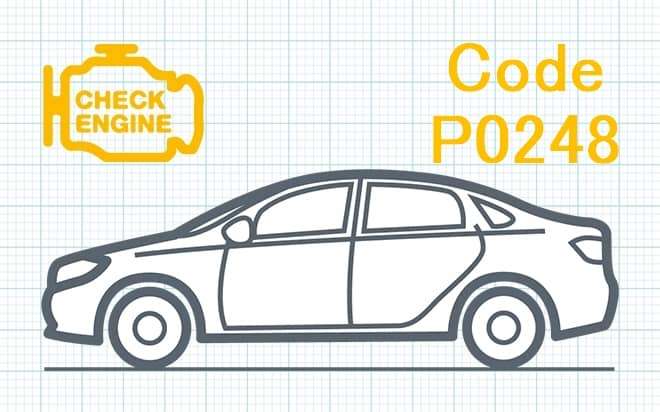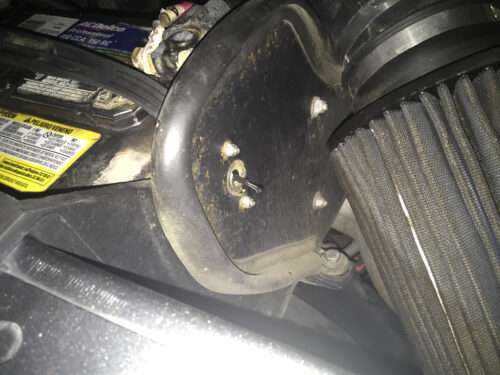
P0248 Turbocharger wastegate solenoid “B” signal level is out of range
Content
P0248 – OBD-II Trouble Code Technical Description
Trouble code P0248 indicates a problem with the turbocharger wastegate solenoid “B” signal level.
What does the fault code mean P0248?
DTC P0248 indicates that an abnormal voltage is detected in the wastegate solenoid “B” circuit by the Engine Control Module (ECM). This means that the signal coming from solenoid “B” is not at the expected voltage, which may indicate problems with the solenoid itself, the wiring, or other components of the boost control system.

Possible reasons
Possible causes of DTC P0248:
- Faulty bypass valve solenoid “B”: The solenoid itself may be damaged or malfunctioning due to wear or poor functioning.
- Solenoid “B” Wiring: The wiring connecting the solenoid to the engine control module (ECM) may be damaged, broken, or have poor connections, resulting in improper signal transmission.
- Short circuit or open circuit: Incorrect wiring or damaged wiring may cause a short or open in the “B” solenoid circuit, causing P0248.
- Problems with the engine control module (ECM): A malfunction of the engine control module itself may cause abnormal voltage in the solenoid “B” circuit.
- Problems with the electrical system: Voltage in the vehicle's electrical system may be unstable due to problems with the battery, alternator, or other components.
- Grounding problems: Insufficient grounding or grounding problems can also cause trouble code P0248.
- Problems with other components of the boost control system: Failures of other components, such as sensors or valves, can also cause P0248.
To accurately determine the cause of the P0248 code, it is recommended to conduct a thorough diagnosis, including testing the solenoid, wiring, circuit, and other components of the boost control system.
What are the symptoms of a fault code? P0248?
Symptoms for a P0248 trouble code can vary depending on the specific problem and vehicle type, but typically include the following:
- Loss of power: If the bypass valve does not function properly due to a faulty solenoid, it may result in loss of engine power.
- Acceleration issues: A faulty bypass valve may cause delay or inadequate acceleration when pressing the accelerator pedal.
- Unusual sounds: You may hear strange noises from the turbo or engine area, such as whistling, clicking, or noises, which may indicate wastegate valve problems.
- Turbo problems: A malfunctioning wastegate valve can cause problems with boost pressure regulation, which can lead to unstable operation of the turbocharger or even damage to the turbocharger.
- Increased fuel consumption: Improper operation of the bypass valve can result in excessive fuel consumption due to inefficient engine operation.
- Check Engine light on: Trouble code P0248 can cause the Check Engine light to illuminate on your vehicle's dashboard.
If you experience the above symptoms or your Check Engine Light comes on, it is recommended that you take it to a qualified auto mechanic to diagnose and repair the problem.
How to diagnose a fault code P0248?
To diagnose DTC P0248, follow these steps:
- Scan error code: Using a diagnostic scan tool, connect it to the vehicle's OBD-II port and read the error codes. Confirm the presence of code P0248.
- Bypass Valve Solenoid “B” Check: Check bypass valve solenoid “B” for operation. This may include checking the solenoid's electrical resistance, circuitry, and mechanical integrity. The solenoid can also be inspected in situ without removing it.
- Checking the wiring: Inspect the wiring connecting the solenoid to the engine control module (ECM) for damage, breaks, or corrosion. Make sure all connections are well secured and connected.
- Solenoid “B” Circuit Check: Using a multimeter, check the voltage in the solenoid “B” circuit under various conditions (for example, with the ignition on and the engine running). The voltage required must be within the manufacturer's specifications.
- Checking the Engine Control Module (ECM): Check the engine control module for malfunctions or errors. This may require specialized hardware and software.
- Checking other components of the charging system: Check other components of the boost system, such as valves or sensors, for problems that could cause the P0248 code.
- Clearing errors and rechecking: After diagnosing and fixing the problem, reset the errors using a diagnostic scanner and recheck the system.
If you do not have experience diagnosing and repairing vehicles, it is recommended that you contact a qualified auto mechanic or auto repair shop for assistance.
Diagnostic errors
When diagnosing DTC P0248, the following errors may occur:
- Incorrect solenoid diagnosis: Incorrect interpretation of the solenoid test results may lead to an erroneous conclusion about its condition. For example, a solenoid may be fine, but the problem may be with its electrical circuit or control module.
- Missing wiring or connectors: Failure to correctly assess the condition of wiring or connectors may result in missing the cause of the error. It is important to carefully check all connections and wiring for damage or corrosion.
- Control module malfunction: If the problem cannot be found in the solenoid or wiring, the error may be that the engine control module (ECM) is faulty.
- Omission of other components of the charging system: Incorrect diagnosis can lead to missing other components of the boost system, which may also be the cause of the P0248 code.
- Wrong fix: Making the wrong decision to replace a component or perform unnecessary repairs may result in additional problems or failure to resolve the error.
To avoid these errors, it is important to conduct a thorough diagnosis, following the vehicle manufacturer's recommendations and using the appropriate diagnostic equipment.
How serious is the fault code? P0248?
Trouble code P0248 indicates a problem with the wastegate solenoid “B” in the boost system. Although this code is not the most serious, it still requires attention and immediate resolution. Improper operation of the bypass valve can result in loss of engine power, poor performance, and increased fuel consumption. In addition, a malfunction in the boost system can cause more serious problems such as damage to the turbocharger.
Therefore, it is recommended that you have a qualified auto mechanic diagnose and repair the problem associated with the P0248 code as soon as possible. The sooner the problem is solved, the less likely there are serious consequences for the operation of the engine and charging system.
What repair will help eliminate the code? P0248?
Troubleshooting DTC P0248 may require the following steps, depending on the detected cause of the problem:
- Bypass Valve Solenoid “B” Replacement: If the solenoid is faulty or not functioning properly, it should be replaced with a new one that meets the manufacturer's specifications.
- Repair or replacement of wiring and connectors: Check the wiring and connectors connecting the solenoid to the engine control module (ECM) for damage, breaks, or corrosion. If necessary, replace damaged wires or connectors and repair any corrosion.
- Checking and cleaning the turbocharger filter: If the problem is a clogged or defective turbocharger filter, check for blockage and clean or replace if necessary.
- Checking and servicing the boost system: Diagnose the entire charging system, including pressure and sensors, to rule out other possible causes of the error.
- Programming or software updateNote: In some cases, updating the engine control module (ECM) software may help resolve the problem.
Before carrying out repair work, it is recommended to conduct a thorough diagnosis to accurately determine the cause of the P0248 code. If you do not have experience with automotive repairs or diagnostics, it is recommended that you contact a qualified auto mechanic or auto repair shop for assistance.
P0248 – Brand-specific information
Trouble code P0248 can be found on various brands of vehicles, below are some examples of vehicle brands with their meanings:
- Volkswagen/VW: On Volkswagen vehicles, code P0248 may be related to the “Boost Control Solenoid Valve.”
- Ford: On Ford vehicles, this code may refer to the “Turbo Charge Control Solenoid Valve.”
- Chevrolet / Chevy: On Chevrolet vehicles, code P0248 may be associated with the “Boost Pressure Control Solenoid Valve.”
- Toyota: On Toyota vehicles, this code may be associated with the “Turbo Control Solenoid”.
- Audi: On Audi vehicles, this code may indicate “Turbo wastegate solenoid malfunction.”
Please refer to your vehicle's specific model and year documentation for more specific information about deciphering the P0248 code for your specific vehicle.
